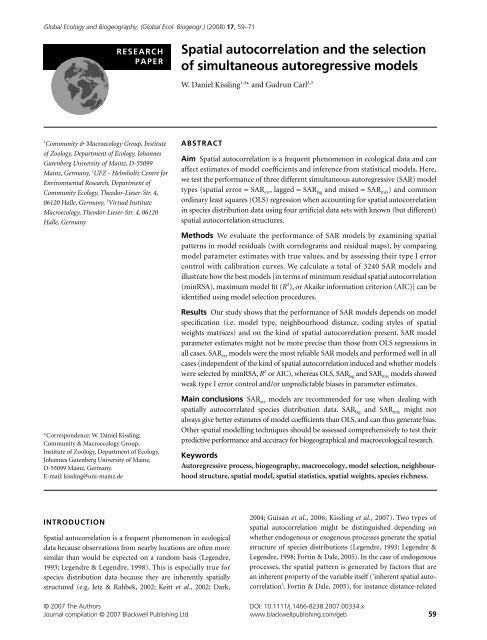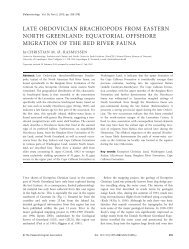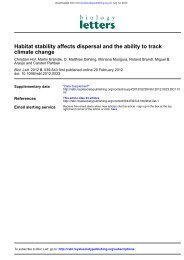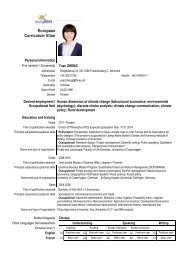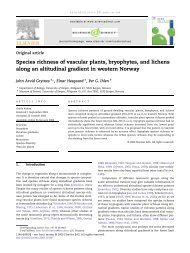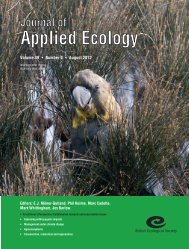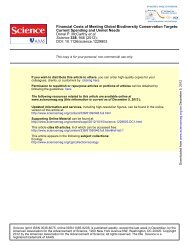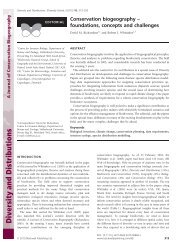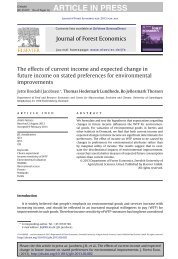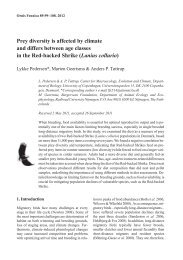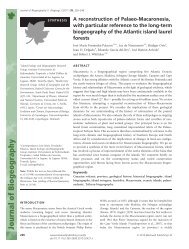Spatial autocorrelation and the selection of ... - 192.38.112.111
Spatial autocorrelation and the selection of ... - 192.38.112.111
Spatial autocorrelation and the selection of ... - 192.38.112.111
Create successful ePaper yourself
Turn your PDF publications into a flip-book with our unique Google optimized e-Paper software.
Global Ecology <strong>and</strong> Biogeography, (Global Ecol. Biogeogr.) (2008) 17, 59–71<br />
Blackwell Publishing Ltd<br />
RESEARCH<br />
PAPER<br />
<strong>Spatial</strong> <strong>autocorrelation</strong> <strong>and</strong> <strong>the</strong> <strong>selection</strong><br />
<strong>of</strong> simultaneous autoregressive models<br />
W. Daniel Kissling 1,3 * <strong>and</strong> Gudrun Carl 2,3<br />
1 Community & Macroecology Group, Institute<br />
<strong>of</strong> Zoology, Department <strong>of</strong> Ecology, Johannes<br />
Gutenberg University <strong>of</strong> Mainz, D-55099<br />
Mainz, Germany, 2 UFZ - Helmholtz Centre for<br />
Environmental Research, Department <strong>of</strong><br />
Community Ecology, Theodor-Lieser-Str. 4,<br />
06120 Halle, Germany, 3 Virtual Institute<br />
Macroecology, Theodor-Lieser-Str. 4, 06120<br />
Halle, Germany<br />
ABSTRACT<br />
Aim <strong>Spatial</strong> <strong>autocorrelation</strong> is a frequent phenomenon in ecological data <strong>and</strong> can<br />
affect estimates <strong>of</strong> model coefficients <strong>and</strong> inference from statistical models. Here,<br />
we test <strong>the</strong> performance <strong>of</strong> three different simultaneous autoregressive (SAR) model<br />
types (spatial error = SAR err , lagged = SAR lag <strong>and</strong> mixed = SAR mix ) <strong>and</strong> common<br />
ordinary least squares (OLS) regression when accounting for spatial <strong>autocorrelation</strong><br />
in species distribution data using four artificial data sets with known (but different)<br />
spatial <strong>autocorrelation</strong> structures.<br />
Methods We evaluate <strong>the</strong> performance <strong>of</strong> SAR models by examining spatial<br />
patterns in model residuals (with correlograms <strong>and</strong> residual maps), by comparing<br />
model parameter estimates with true values, <strong>and</strong> by assessing <strong>the</strong>ir type I error<br />
control with calibration curves. We calculate a total <strong>of</strong> 3240 SAR models <strong>and</strong><br />
illustrate how <strong>the</strong> best models [in terms <strong>of</strong> minimum residual spatial <strong>autocorrelation</strong><br />
(minRSA), maximum model fit (R 2 ), or Akaike information criterion (AIC)] can be<br />
identified using model <strong>selection</strong> procedures.<br />
Results Our study shows that <strong>the</strong> performance <strong>of</strong> SAR models depends on model<br />
specification (i.e. model type, neighbourhood distance, coding styles <strong>of</strong> spatial<br />
weights matrices) <strong>and</strong> on <strong>the</strong> kind <strong>of</strong> spatial <strong>autocorrelation</strong> present. SAR model<br />
parameter estimates might not be more precise than those from OLS regressions in<br />
all cases. SAR err models were <strong>the</strong> most reliable SAR models <strong>and</strong> performed well in all<br />
cases (independent <strong>of</strong> <strong>the</strong> kind <strong>of</strong> spatial <strong>autocorrelation</strong> induced <strong>and</strong> whe<strong>the</strong>r models<br />
were selected by minRSA, R 2 or AIC), whereas OLS, SAR lag <strong>and</strong> SAR mix models showed<br />
weak type I error control <strong>and</strong>/or unpredictable biases in parameter estimates.<br />
*Correspondence: W. Daniel Kissling,<br />
Community & Macroecology Group,<br />
Institute <strong>of</strong> Zoology, Department <strong>of</strong> Ecology,<br />
Johannes Gutenberg University <strong>of</strong> Mainz,<br />
D-55099 Mainz, Germany.<br />
E-mail: kissling@uni-mainz.de<br />
Main conclusions SAR err models are recommended for use when dealing with<br />
spatially autocorrelated species distribution data. SAR lag <strong>and</strong> SAR mix might not<br />
always give better estimates <strong>of</strong> model coefficients than OLS, <strong>and</strong> can thus generate bias.<br />
O<strong>the</strong>r spatial modelling techniques should be assessed comprehensively to test <strong>the</strong>ir<br />
predictive performance <strong>and</strong> accuracy for biogeographical <strong>and</strong> macroecological research.<br />
Keywords<br />
Autoregressive process, biogeography, macroecology, model <strong>selection</strong>, neighbourhood<br />
structure, spatial model, spatial statistics, spatial weights, species richness.<br />
INTRODUCTION<br />
<strong>Spatial</strong> <strong>autocorrelation</strong> is a frequent phenomenon in ecological<br />
data because observations from nearby locations are <strong>of</strong>ten more<br />
similar than would be expected on a r<strong>and</strong>om basis (Legendre,<br />
1993; Legendre & Legendre, 1998). This is especially true for<br />
species distribution data because <strong>the</strong>y are inherently spatially<br />
structured (e.g. Jetz & Rahbek, 2002; Keitt et al., 2002; Dark,<br />
2004; Guisan et al., 2006; Kissling et al., 2007). Two types <strong>of</strong><br />
spatial <strong>autocorrelation</strong> might be distinguished depending on<br />
whe<strong>the</strong>r endogenous or exogenous processes generate <strong>the</strong> spatial<br />
structure <strong>of</strong> species distributions (Legendre, 1993; Legendre &<br />
Legendre, 1998; Fortin & Dale, 2005). In <strong>the</strong> case <strong>of</strong> endogenous<br />
processes, <strong>the</strong> spatial pattern is generated by factors that are<br />
an inherent property <strong>of</strong> <strong>the</strong> variable itself (‘inherent spatial <strong>autocorrelation</strong>’;<br />
Fortin & Dale, 2005), for instance distance-related<br />
© 2007 The Authors DOI: 10.1111/j.1466-8238.2007.00334.x<br />
Journal compilation © 2007 Blackwell Publishing Ltd www.blackwellpublishing.com/geb 59
W. D. Kissling <strong>and</strong> G. Carl<br />
biotic processes such as reproduction, dispersal, speciation,<br />
extinction or geographical range extension (Legendre, 1993;<br />
Diniz-Filho et al., 2003). On <strong>the</strong> o<strong>the</strong>r h<strong>and</strong>, spatial <strong>autocorrelation</strong><br />
can be induced by exogenous processes that are independent <strong>of</strong><br />
<strong>the</strong> variable <strong>of</strong> interest (‘induced spatial dependence’; Fortin &<br />
Dale, 2005). These are most likely spatially structured environmental<br />
factors such as geomorphological processes, wind, energy<br />
input or climatic constraints, which can cause species distributions<br />
to be spatially structured (Legendre, 1993; Diniz-Filho et al.,<br />
2003).<br />
Irrespective <strong>of</strong> which processes cause <strong>the</strong> spatial structure <strong>of</strong><br />
species distributions, <strong>the</strong> presence <strong>of</strong> spatial <strong>autocorrelation</strong> is<br />
problematic for classical statistical tests (anova, correlation <strong>and</strong><br />
regression) because <strong>the</strong>se methods assume independently<br />
distributed errors (Legendre, 1993; Legendre & Legendre, 1998).<br />
The first problem relates to <strong>the</strong> inflation <strong>of</strong> type I errors, which<br />
means that confidence intervals are wrongly estimated when<br />
observations are not independent, <strong>and</strong> hence classical tests <strong>of</strong><br />
significance <strong>of</strong> correlation or regression coefficients might be<br />
biased (Legendre, 1993; Lennon, 2000; Legendre et al., 2002).<br />
The second problem applies to shifts in model coefficients<br />
between non-spatial <strong>and</strong> spatial regression models, which affects<br />
our ability to evaluate <strong>the</strong> importance <strong>of</strong> explanatory variables<br />
(Lennon, 2000; Lichstein et al., 2002). This can be a serious<br />
shortcoming for hypo<strong>the</strong>sis testing <strong>and</strong> inference from statistical<br />
models (Dormann, 2007) <strong>and</strong> might even invert <strong>the</strong> interpretation<br />
<strong>of</strong> environmental effects on species distributions (Kühn,<br />
2007). One <strong>the</strong>refore needs to test for <strong>the</strong> presence <strong>of</strong> spatial<br />
<strong>autocorrelation</strong> in <strong>the</strong> residuals <strong>of</strong> regression models when<br />
modelling species distributions to evaluate whe<strong>the</strong>r type I errors<br />
<strong>and</strong> shifts in parameter estimates are likely to occur.<br />
A number <strong>of</strong> methods exist to deal with spatial <strong>autocorrelation</strong><br />
in ecological data (Cressie, 1993; Haining, 2003; Diniz-Filho &<br />
Bini, 2005; Fortin & Dale, 2005; Rangel et al., 2006). One <strong>of</strong> <strong>the</strong>se<br />
is spatial regression models, such as simultaneous autoregressive<br />
(SAR) models (Cressie, 1993; Haining, 2003), which augment<br />
<strong>the</strong> st<strong>and</strong>ard linear regression model with an additional term<br />
that incorporates <strong>the</strong> spatial <strong>autocorrelation</strong> structure <strong>of</strong> a given<br />
data set. This additional term is implemented with a ‘spatial<br />
weights matrix’ where <strong>the</strong> neighbourhood <strong>of</strong> each location<br />
(e.g. defined by distance) <strong>and</strong> <strong>the</strong> weight <strong>of</strong> each neighbour<br />
(e.g. closer neighbours might receive higher weights) need<br />
to be defined (e.g. Anselin & Bera, 1998; Fortin & Dale, 2005).<br />
The spatial dependence <strong>of</strong> a location on neighbouring sites is<br />
<strong>the</strong>n modelled with a variance–covariance matrix based on <strong>the</strong><br />
defined spatial weights matrix (for details see Cressie, 1993;<br />
Anselin, 1988, 2002; Anselin & Bera, 1998; Fortin & Dale, 2005).<br />
The spatial weights matrix in SAR models thus accounts for<br />
patterns in <strong>the</strong> response variable that are not predicted by<br />
explanatory variables, but are instead related to values in<br />
neighbouring locations.<br />
Although SAR <strong>and</strong> o<strong>the</strong>r autoregressive models have been<br />
known for decades in <strong>the</strong> statistical literature (Besag, 1974; Cliff<br />
& Ord, 1981), <strong>the</strong>ir application in ecology <strong>and</strong> species distribution<br />
research has been limited up to now (e.g. Jetz & Rahbek, 2002;<br />
Keitt et al., 2002; Lichstein et al., 2002; Dark, 2004; Tognelli &<br />
Kelt, 2004; Kissling et al., 2007). One reason might be that <strong>the</strong><br />
implementation <strong>of</strong> autoregressive models is ma<strong>the</strong>matically<br />
complex (Cressie, 1993) <strong>and</strong> computationally intensive (Rangel<br />
et al., 2006), <strong>and</strong> freely available s<strong>of</strong>tware packages have just<br />
recently become available (R Development Core Team, 2005;<br />
Rangel et al., 2006). As a consequence, most applications <strong>of</strong><br />
autoregressive models in ecology have so far restricted <strong>the</strong> range<br />
<strong>of</strong> available options to incorporate spatial interaction. For<br />
instance, most studies have not tested a variety <strong>of</strong> possible model<br />
specifications (e.g. different neighbourhood distances, model<br />
types or coding styles for <strong>the</strong> spatial weights matrix), nor have<br />
<strong>the</strong>y systematically investigated <strong>the</strong>ir potential to account<br />
for spatial <strong>autocorrelation</strong>, including <strong>the</strong> precision <strong>of</strong> <strong>the</strong>ir<br />
parameter estimates. Moreover, model <strong>selection</strong> procedures,<br />
which allow <strong>the</strong> identification <strong>of</strong> a single best model or a set <strong>of</strong><br />
models (Burnham & Anderson, 1998; Johnson & Oml<strong>and</strong>,<br />
2004), are largely absent for spatially autocorrelated data (see<br />
Hoeting et al., 2006).<br />
In this paper, we tested <strong>the</strong> potential <strong>of</strong> three different SAR<br />
model types (spatial error model, lagged model <strong>and</strong> mixed<br />
model) with 27 spatial weights matrices (based on nine<br />
neighbourhood distances <strong>and</strong> three different neighbourhood<br />
weights) to account for spatial <strong>autocorrelation</strong> in four artificial<br />
species distribution data sets with known spatial properties. All<br />
four data sets had <strong>the</strong> same relationship between <strong>the</strong> response<br />
variable <strong>and</strong> <strong>the</strong> two explanatory variables <strong>and</strong> only differed in<br />
<strong>the</strong> way that spatial <strong>autocorrelation</strong> was induced. This allowed us<br />
to systematically investigate <strong>the</strong> potential <strong>of</strong> SAR models to<br />
account for certain types <strong>of</strong> spatial <strong>autocorrelation</strong> structures,<br />
including <strong>the</strong> evaluation <strong>of</strong> <strong>the</strong> precision <strong>of</strong> parameter estimates<br />
<strong>and</strong> type I error controls. Moreover, we illustrate how <strong>the</strong> best<br />
SAR models can be selected from a range <strong>of</strong> model specifications<br />
using model <strong>selection</strong> procedures based on minimum residual<br />
spatial <strong>autocorrelation</strong> (minRSA), maximum model fit (R 2 ) <strong>and</strong><br />
<strong>the</strong> Akaike information criterion (AIC). The construction <strong>and</strong><br />
evaluation <strong>of</strong> SAR models was implemented with <strong>the</strong> free<br />
s<strong>of</strong>tware R (R Development Core Team, 2005) to enable<br />
ecologists to freely use <strong>the</strong> methods presented here.<br />
MATERIALS AND METHODS<br />
Simultaneous autoregressive models<br />
Simultaneous autoregressive models assume that <strong>the</strong> response at<br />
each location i is a function not only <strong>of</strong> <strong>the</strong> explanatory variable<br />
at i, but <strong>of</strong> <strong>the</strong> values <strong>of</strong> <strong>the</strong> response at neighbouring locations<br />
j as well (Cressie, 1993; Lichstein et al., 2002; Haining, 2003).<br />
In SAR, <strong>the</strong> neighbourhood relationship is formally expressed in<br />
a n × n matrix <strong>of</strong> spatial weights (W), with elements (w ij ) representing<br />
a measure <strong>of</strong> <strong>the</strong> connection between locations i <strong>and</strong> j.<br />
The specification <strong>of</strong> <strong>the</strong> spatial weights matrix starts by identifying<br />
<strong>the</strong> neighbourhood structure <strong>of</strong> each cell. This neighbourhood<br />
can be identified by, for example, <strong>the</strong> adjacency <strong>of</strong> cells on a grid<br />
map, or by Euclidean or great circle distance (e.g. <strong>the</strong> distance<br />
along Earth’s surface) to define cells within or outside a respective<br />
neighbourhood. The neighbours can fur<strong>the</strong>r be weighted to give<br />
© 2007 The Authors<br />
60 Global Ecology <strong>and</strong> Biogeography, 17, 59–71, Journal compilation © 2007 Blackwell Publishing Ltd
Simultaneous autoregressive model <strong>selection</strong><br />
closer neighbours higher weights <strong>and</strong> more distant neighbours<br />
lower weights. A number <strong>of</strong> methods are available for coding <strong>the</strong><br />
spatial weights matrix (see Biv<strong>and</strong>, 2006), for example: (1)<br />
binary coding (locations are ei<strong>the</strong>r listed as neighbours or not);<br />
(2) row-st<strong>and</strong>ardization (which scales <strong>the</strong> covariances based on<br />
<strong>the</strong> number <strong>of</strong> neighbours <strong>of</strong> each region in each row <strong>of</strong> <strong>the</strong><br />
spatial weights matrix); or (3) variance stabilization (stabilizes<br />
variances by summing over all links, for details see Tiefelsdorf<br />
et al., 1999). The final matrix <strong>of</strong> spatial weights W consists <strong>of</strong><br />
zeros on <strong>the</strong> diagonal, <strong>and</strong> weights for <strong>the</strong> neighbouring<br />
locations (w ij ) in <strong>the</strong> <strong>of</strong>f-diagonal positions.<br />
Three different SAR models will be distinguished here<br />
depending on where <strong>the</strong> spatial autoregressive process is believed<br />
to occur (for details see Cliff & Ord, 1981; Anselin, 1988;<br />
Haining, 2003). The spatial error model (SAR err ) assumes that<br />
<strong>the</strong> autoregressive process is found only in <strong>the</strong> error term. This is<br />
most likely <strong>the</strong> case if spatial <strong>autocorrelation</strong> is not fully<br />
explained by <strong>the</strong> included explanatory variables (‘induced spatial<br />
dependence’), e.g. if an important spatially structured explanatory<br />
variable has not been taken into account (Diniz-Filho et al.,<br />
2003) or if spatial <strong>autocorrelation</strong> is an inherent property <strong>of</strong><br />
<strong>the</strong> response variable itself (‘inherent spatial <strong>autocorrelation</strong>’).<br />
For <strong>the</strong> SAR err , <strong>the</strong> usual OLS regression model (Y = Xβ + e) is<br />
complemented by a term (λWu) which represents <strong>the</strong> spatial<br />
structure (λW) in <strong>the</strong> spatially dependent error term (u).<br />
The SAR err thus takes <strong>the</strong> form<br />
Y = Xβ + λWu + e<br />
where λ is <strong>the</strong> spatial autoregression coefficient, W is <strong>the</strong> spatial<br />
weights matrix, β is a vector representing <strong>the</strong> slopes associated<br />
with <strong>the</strong> explanatory variables in <strong>the</strong> original predictor matrix X,<br />
<strong>and</strong> e represents <strong>the</strong> (spatially) independent errors.<br />
Second, <strong>the</strong> SAR lagged model (SAR lag ) assumes that <strong>the</strong><br />
autoregressive process occurs only in <strong>the</strong> response variable<br />
(‘inherent spatial <strong>autocorrelation</strong>’), <strong>and</strong> thus includes a term<br />
(ρW) for <strong>the</strong> spatial <strong>autocorrelation</strong> in <strong>the</strong> response variable Y,<br />
but also <strong>the</strong> st<strong>and</strong>ard term for <strong>the</strong> explanatory variables <strong>and</strong><br />
errors (Xβ + e) as used in an ordinary least squares (OLS)<br />
regression. The SAR lag takes <strong>the</strong> form<br />
Y = ρWY + Xβ + e<br />
where ρ is <strong>the</strong> autoregression coefficient, <strong>and</strong> <strong>the</strong> remaining<br />
terms are as above.<br />
Finally, spatial <strong>autocorrelation</strong> can affect both response <strong>and</strong><br />
explanatory variables (having both ‘inherent spatial <strong>autocorrelation</strong>’<br />
<strong>and</strong> ‘induced spatial dependence’). In this case, ano<strong>the</strong>r<br />
term (WXγ) must additionally appear in <strong>the</strong> model, which<br />
describes <strong>the</strong> autoregression coefficient (γ) <strong>of</strong> <strong>the</strong> spatially lagged<br />
explanatory variables (WX). The SAR mixed model (SAR mix )<br />
takes <strong>the</strong> form<br />
Y = ρWY + Xβ + WXγ + e.<br />
For more details on SAR models <strong>and</strong> <strong>the</strong> estimation <strong>of</strong> <strong>the</strong><br />
covariance matrices see Cliff & Ord (1981), Anselin (1988, 2002),<br />
Cressie (1993), Haining (2003) <strong>and</strong> Fortin & Dale (2005).<br />
How to construct SAR models in R<br />
The implementation <strong>of</strong> SAR models is illustrated here with <strong>the</strong><br />
free s<strong>of</strong>tware R (R Development Core Team 2005). The three<br />
SAR model types (SAR err , SAR lag , SAR mix ) are implemented in R<br />
in <strong>the</strong> library ‘spdep’ (Biv<strong>and</strong>, 2006). To use <strong>the</strong> SAR functions in<br />
R, one needs to specify <strong>the</strong> neighbourhood distances first, <strong>and</strong><br />
<strong>the</strong> spatial weights matrix is <strong>the</strong>n calculated by weighting<br />
<strong>the</strong> neighbours with a certain coding scheme (e.g. binary, row<br />
st<strong>and</strong>ardized or variance-stabilizing coding scheme, see above).<br />
A more detailed, annotated code to construct SAR models in R is<br />
given in Appendix S1 (see Supplementary Material).<br />
Data<br />
Four artificial data sets were created containing information on<br />
species distribution <strong>of</strong> a virtual organism <strong>and</strong> two environmental<br />
variables (‘rain’ <strong>and</strong> ‘jungle’). The four data sets were modified<br />
versions <strong>of</strong> <strong>the</strong> freely available R volcano data set (R Development<br />
Core Team, 2005), which gives topographic information on<br />
<strong>the</strong> Maunga Whau volcano near Auckl<strong>and</strong>, New Zeal<strong>and</strong>, on a<br />
10 × 10 m grid. The extent <strong>of</strong> <strong>the</strong> grid (5307 grid cells) was<br />
first reduced to 1108 cells by simply increasing sea levels. Two<br />
explanatory variables, ‘rain’ <strong>and</strong> ‘jungle’, were <strong>the</strong>n created.<br />
The variable rain (assumed to describe annual precipitation) was<br />
a significant determinant <strong>of</strong> <strong>the</strong> virtual organism distribution in<br />
all data sets, whereas <strong>the</strong> variable jungle (assumed to describe <strong>the</strong><br />
percentage <strong>of</strong> jungle cover) did not have any explanatory<br />
power (noise). In all four data sets, <strong>the</strong> data on virtual organism<br />
distribution were normally distributed <strong>and</strong> had <strong>the</strong> same<br />
relationship to <strong>the</strong> explanatory variables rain <strong>and</strong> jungle, based<br />
on <strong>the</strong> following underlying model:<br />
expected value (virtual organism) =<br />
80 − (0.015 × rain) + (0 × jungle)<br />
The data sets differed, however, in <strong>the</strong> way in which spatial<br />
<strong>autocorrelation</strong> was induced. We first simulated three artificial<br />
data sets, which correspond to <strong>the</strong> ma<strong>the</strong>matical formulation <strong>of</strong><br />
<strong>the</strong> three model types for spatial externalities (Anselin, 2003).<br />
These data sets might <strong>the</strong>refore comprise ecologically borderline<br />
cases <strong>and</strong> were simulated with <strong>the</strong> aim <strong>of</strong> illustrating <strong>the</strong><br />
performance <strong>of</strong> SAR models under extreme conditions. In all<br />
three cases we included spatial <strong>autocorrelation</strong> by multiplying a<br />
vector or matrix by <strong>the</strong> transpose <strong>of</strong> <strong>the</strong> Cholesky decomposition<br />
C T <strong>of</strong> a pre-specified variance–covariance matrix. However, <strong>the</strong><br />
data sets differed in where C T was incorporated. In <strong>the</strong> ‘error<br />
data’, normally distributed errors containing spatial <strong>autocorrelation</strong><br />
were added to <strong>the</strong> linear predictor (Y = Xβ + C T e), <strong>and</strong> spatial<br />
<strong>autocorrelation</strong> was thus only present in <strong>the</strong> errors but not in <strong>the</strong><br />
response variable or in <strong>the</strong> explanatory variables (see Fig. 1a). In<br />
real-case field data, this spatial <strong>autocorrelation</strong> pattern could, for<br />
instance, be caused by not taking into account <strong>the</strong> ‘induced<br />
spatial dependence’ <strong>of</strong> an important spatially structured explanatory<br />
variable (see Diniz-Filho et al., 2003), or if spatial <strong>autocorrelation</strong><br />
is an inherent property <strong>of</strong> <strong>the</strong> response variable itself (‘inherent<br />
© 2007 The Authors<br />
Global Ecology <strong>and</strong> Biogeography, 17, 59–71, Journal compilation © 2007 Blackwell Publishing Ltd 61
W. D. Kissling <strong>and</strong> G. Carl<br />
Figure 1 <strong>Spatial</strong> distribution <strong>of</strong> variables from four artificial data sets with different spatial <strong>autocorrelation</strong> structures. (a) Error data with<br />
spatial <strong>autocorrelation</strong> in errors only. (b) Lag data with spatial <strong>autocorrelation</strong> in both explanatory variables (rain, jungle) <strong>and</strong> in <strong>the</strong> distribution<br />
<strong>of</strong> <strong>the</strong> virtual organism, but not in <strong>the</strong> errors. (c) Mixed data with spatial <strong>autocorrelation</strong> in all variables. (d) Dormann data with spatial<br />
<strong>autocorrelation</strong> in virtual organism distribution <strong>and</strong> errors, <strong>and</strong> additional correlation (independent <strong>of</strong> errors) in rain. In all data sets, <strong>the</strong><br />
relationship between response <strong>and</strong> explanatory variables is <strong>the</strong> same [E(virtual organism) = 80 − (0.015 × rain) + (0 × jungle)]. Equal-interval<br />
classification is shown, with light grey indicating minimum <strong>and</strong> black indicating maximum values. See text for more details.<br />
spatial <strong>autocorrelation</strong>’) <strong>and</strong> thus is not explained by <strong>the</strong><br />
included explanatory variables. In <strong>the</strong> ‘lag data’, <strong>the</strong> spatial<br />
<strong>autocorrelation</strong> was incorporated in <strong>the</strong> explanatory variables<br />
only but not in <strong>the</strong> errors (Y = C T Xβ + e), causing a spatial lag in<br />
<strong>the</strong> distribution <strong>of</strong> <strong>the</strong> virtual organism (Fig. 1b). This reflects<br />
<strong>the</strong> situation where all spatial <strong>autocorrelation</strong> in <strong>the</strong> response<br />
variable comes from exogenous processes (‘induced spatial<br />
dependence’), here from one spatially structured environmental<br />
© 2007 The Authors<br />
62 Global Ecology <strong>and</strong> Biogeography, 17, 59–71, Journal compilation © 2007 Blackwell Publishing Ltd
Simultaneous autoregressive model <strong>selection</strong><br />
variable. In <strong>the</strong> ‘mixed data’ (Fig. 1c), spatial <strong>autocorrelation</strong><br />
was included in both <strong>the</strong> errors <strong>and</strong> <strong>the</strong> explanatory variables<br />
(Y = C T Xβ + C T e). Both explanatory variables, response <strong>and</strong><br />
errors thus showed a spatially structured distribution (Fig. 1c).<br />
This pattern can arise if both endogenous <strong>and</strong> exogenous<br />
processes play a role (i.e. ‘inherent spatial <strong>autocorrelation</strong>’ <strong>and</strong><br />
‘induced spatial dependence’). Note that <strong>the</strong> taxonomy used for<br />
describing <strong>the</strong> spatial <strong>autocorrelation</strong> in our data is similar to <strong>the</strong><br />
formulation <strong>of</strong> <strong>the</strong> SAR model types, although <strong>the</strong> underlying<br />
regression models are not completely in line with <strong>the</strong>m.<br />
The fourth data set (‘data Dormann’, provided by C.F.<br />
Dormann) aimed to mimic ecological data <strong>and</strong> is <strong>the</strong> one<br />
currently used in a comprehensive evaluation <strong>of</strong> several statistical<br />
procedures to deal with spatial <strong>autocorrelation</strong> in statistical<br />
models (C.F. Dormann et al., unpublished). In this fourth<br />
artificial data set, both explanatory variables (rain, jungle) were<br />
simulated with <strong>the</strong> same mean <strong>and</strong> <strong>the</strong> same variance as in <strong>the</strong><br />
data above. The response variable (i.e. distribution <strong>of</strong> <strong>the</strong> virtual<br />
organism) was also calculated with <strong>the</strong> same formula as above,<br />
<strong>and</strong> normally distributed errors containing spatial <strong>autocorrelation</strong><br />
(by multiplying <strong>the</strong>m by <strong>the</strong> transpose <strong>of</strong> <strong>the</strong> same Cholesky<br />
decomposition C T ) were <strong>the</strong>n incorporated in <strong>the</strong> distribution<br />
data for <strong>the</strong> virtual organism (Fig. 1d). In contrast to <strong>the</strong> data<br />
above, <strong>the</strong> spatial distribution <strong>of</strong> <strong>the</strong> variable rain was simulated<br />
to have a spatially structured pattern around <strong>the</strong> volcano in <strong>the</strong><br />
centre <strong>of</strong> <strong>the</strong> map, with highest values in <strong>the</strong> western part <strong>of</strong> <strong>the</strong><br />
study area. This spatial structure was created by adding a<br />
geographical pattern to rain. Hence, <strong>the</strong>re is no collinearity<br />
between <strong>the</strong> rain pattern <strong>and</strong> <strong>the</strong> spatial distribution <strong>of</strong> <strong>the</strong><br />
virtual organism <strong>and</strong> <strong>the</strong> errors (Fig. 1d). The variable jungle was<br />
purely r<strong>and</strong>omly distributed in space (Fig. 1d).<br />
SAR model performance<br />
We first calculated all SAR models (SAR err , SAR lag , SAR mix ) with<br />
<strong>the</strong> same spatial weights matrix, i.e. an arbitrarily (but commonly)<br />
chosen neighbourhood distance <strong>of</strong> 1.5 <strong>and</strong> a coding style ‘W’ =<br />
row st<strong>and</strong>ardized (see Appendix S1). This was done for all four<br />
artificial data sets to illustrate <strong>the</strong> relative performance <strong>of</strong> SAR<br />
models without applying any model <strong>selection</strong> criteria. We compared<br />
<strong>the</strong> spatial <strong>autocorrelation</strong> pattern in model residuals using<br />
correlograms (Legendre & Fortin, 1989; Legendre, 1993), which<br />
plot Moran’s I values (a measure for <strong>autocorrelation</strong>; Moran,<br />
1950) on <strong>the</strong> y-axis against distance classes <strong>of</strong> sampling stations<br />
on <strong>the</strong> x-axis, <strong>and</strong> thus allow <strong>the</strong> assessment <strong>of</strong> <strong>the</strong> spatial <strong>autocorrelation</strong><br />
pattern with increasing distance. Correlograms <strong>and</strong><br />
Moran’s I values were calculated with <strong>the</strong> function correlog()<br />
from <strong>the</strong> R package ‘ncf’ (Bjørnstad, 2005). We also plotted maps<br />
<strong>of</strong> model residuals to visualize <strong>the</strong>ir spatial pattern. Fur<strong>the</strong>rmore,<br />
we compared model parameter estimates for intercept, rain <strong>and</strong><br />
jungle with <strong>the</strong> true (i.e. known) values (intercept, 80; rain, −0.015;<br />
jungle, 0). For comparison, we also did all calculations with<br />
simple OLS regressions for all data sets.<br />
To assess <strong>the</strong> relative performance <strong>of</strong> parameter estimates in<br />
terms <strong>of</strong> type I errors (i.e. <strong>the</strong> probability α <strong>of</strong> falsely rejecting <strong>the</strong><br />
null hypo<strong>the</strong>sis H 0 : β = 0) we calculated so-called calibration<br />
curves (see Fadili & Bullmore, 2002) where <strong>the</strong> observed number<br />
<strong>of</strong> type I errors (i.e. positive tests per 100 data realizations) is<br />
plotted against <strong>the</strong> expected number <strong>of</strong> type I errors (per 100<br />
data realizations) across <strong>the</strong> full range <strong>of</strong> α. For this purpose,<br />
we generated 100 data realizations for each <strong>of</strong> <strong>the</strong> four data sets.<br />
The 100 data realizations <strong>of</strong> each artificial data set had exactly<br />
<strong>the</strong> same relationships as explained above. The only difference<br />
between <strong>the</strong> 100 realizations was that <strong>the</strong> normally distributed<br />
errors were r<strong>and</strong>omly generated separately each time. We<br />
<strong>the</strong>n calculated all models (SAR err , SAR lag , SAR mix <strong>and</strong> OLS; SAR<br />
models with a neighbourhood distance <strong>of</strong> 1.5 <strong>and</strong> a coding style<br />
‘W’) <strong>and</strong> recorded how <strong>of</strong>ten <strong>the</strong> P value <strong>of</strong> <strong>the</strong> (non-significant)<br />
variable jungle was falsely estimated to be < α. The models work<br />
well when <strong>the</strong> observed number <strong>of</strong> type I errors equals <strong>the</strong><br />
predicted one, i.e. when <strong>the</strong> calibration curve coincides with<br />
<strong>the</strong> line <strong>of</strong> identity given as a straight line in all plots (Fadili &<br />
Bullmore, 2002).<br />
Model <strong>selection</strong><br />
Model <strong>selection</strong> can be helpful to identify a single best model or<br />
to make inferences from a set <strong>of</strong> multiple competing hypo<strong>the</strong>ses<br />
(Johnson & Oml<strong>and</strong>, 2004). Up to now, however, only a few<br />
model <strong>selection</strong> procedures have been tested for spatially autocorrelated<br />
data (e.g. Hoeting et al., 2006). We <strong>the</strong>refore developed<br />
model <strong>selection</strong> procedures <strong>and</strong> selected <strong>the</strong> best SAR<br />
models from a range <strong>of</strong> models (see below) testing three model<br />
<strong>selection</strong> criteria: (1) minimum residual <strong>autocorrelation</strong><br />
(minRSA); (2) maximum model fit (R 2 ); <strong>and</strong> (3) <strong>the</strong> AIC. R 2<br />
values are not directly provided for SAR models, <strong>and</strong> maximum<br />
model fit was thus assessed with a pseudo-R 2 value (in <strong>the</strong> following<br />
simply referred to as R 2 ) calculated as <strong>the</strong> squared Pearson<br />
correlation between predicted <strong>and</strong> observed (i.e. true) values. We<br />
measured minRSA with correlograms (see above) by summing<br />
up <strong>the</strong> absolute Moran’s I values in <strong>the</strong> first 20 distance classes <strong>of</strong><br />
<strong>the</strong> correlogram (similar to C.F. Dormann et al., unpublished).<br />
AIC values are directly provided for SAR models <strong>and</strong> allow<br />
<strong>the</strong> <strong>selection</strong> <strong>of</strong> models based on both model fit <strong>and</strong> model<br />
complexity (Burnham & Anderson, 1998). They are now being<br />
used widely in ecological <strong>and</strong> evolutionary studies (Johnson &<br />
Oml<strong>and</strong>, 2004).<br />
For <strong>the</strong> model <strong>selection</strong> procedures, we simulated 10 data<br />
realizations (similar to those above) for each <strong>of</strong> <strong>the</strong> four artificial<br />
data sets. We chose 10 data realizations here because a larger<br />
number <strong>of</strong> realizations would have been beyond our ability to<br />
test a great variety <strong>and</strong> number <strong>of</strong> SAR models (see below). For<br />
all 10 realizations <strong>of</strong> each <strong>of</strong> <strong>the</strong> four data sets we calculated <strong>the</strong><br />
three SAR model types (SAR lag , SAR mix , SAR err ) with 27 different<br />
spatial weights matrices (i.e. 81 model specifications with 10 data<br />
realizations <strong>and</strong> four data sets = 3240 tested SAR models). The<br />
spatial weights matrices were constructed with nine neighbourhood<br />
distances (from 1 to 5, in steps <strong>of</strong> 0.5). Additionally, three<br />
coding styles (‘B’ = binary coding, ‘W’ = row st<strong>and</strong>ardized, <strong>and</strong><br />
‘S’ = variance stabilizing; see above) were tested. All SAR models<br />
were run with both explanatory variables (rain, jungle). For each<br />
<strong>of</strong> <strong>the</strong> 10 data realizations within each artificial data set we<br />
© 2007 The Authors<br />
Global Ecology <strong>and</strong> Biogeography, 17, 59–71, Journal compilation © 2007 Blackwell Publishing Ltd 63
W. D. Kissling <strong>and</strong> G. Carl<br />
selected <strong>the</strong> best model (based on minRSA, R 2 or AIC) from <strong>the</strong><br />
27 model specifications. We <strong>the</strong>n assessed, for each <strong>of</strong> <strong>the</strong> four<br />
data sets, which SAR models <strong>and</strong> spatial weights matrices (i.e.<br />
neighbourhood distances <strong>and</strong> coding styles) were selected, <strong>and</strong><br />
which performed poorly (in terms <strong>of</strong> parameter estimates) given<br />
a certain spatial <strong>autocorrelation</strong> structure in <strong>the</strong> data. To assess<br />
parameter estimates <strong>of</strong> intercept, rain <strong>and</strong> jungle, we calculated<br />
mean values (±SD) across <strong>the</strong> 10 data realizations from <strong>the</strong> best<br />
models (i.e. selected based on minRSA, R 2 or AIC, respectively),<br />
<strong>and</strong> compared <strong>the</strong>m with <strong>the</strong> true values. For comparison,<br />
simple OLS regressions were also included in <strong>the</strong>se analyses.<br />
RESULTS<br />
SAR model performance<br />
The different spatial <strong>autocorrelation</strong> structures <strong>of</strong> <strong>the</strong> four<br />
artificial data sets (Fig. 1) were not equally detected by <strong>the</strong><br />
different models tested. OLS models generally showed a spatial<br />
<strong>autocorrelation</strong> pattern in <strong>the</strong> residuals for all data sets except <strong>the</strong><br />
lag data (Figs 2 & 3), which contained spatial <strong>autocorrelation</strong> in<br />
<strong>the</strong> explanatory variables <strong>and</strong> <strong>the</strong> response but not in <strong>the</strong> errors<br />
(Fig. 1). For an arbitrarily (but commonly) chosen spatial<br />
weights matrix with a neighbourhood distance <strong>of</strong> 1.5 <strong>and</strong> a<br />
coding style ‘W’ (= row st<strong>and</strong>ardized), <strong>the</strong> SAR lag model was only<br />
able to remove <strong>the</strong> spatial <strong>autocorrelation</strong> in <strong>the</strong> lag data <strong>and</strong> <strong>the</strong><br />
Dormann data but not in <strong>the</strong> two o<strong>the</strong>r data sets where spatial<br />
<strong>autocorrelation</strong> was induced in <strong>the</strong> errors (Figs 2 & 3). The SAR err<br />
<strong>and</strong> SAR mix models with this particular spatial weights matrix<br />
instead performed well, <strong>and</strong> were able to account for <strong>the</strong> spatial<br />
<strong>autocorrelation</strong> structures in all four data sets (Figs 2 & 3). However,<br />
parameter estimates from OLS <strong>and</strong> SAR models (with this<br />
single spatial weights matrix) were not always very precise,<br />
depending on <strong>the</strong> data set analysed (Fig. 4). Those from SAR err<br />
models performed best whereas OLS, SAR lag <strong>and</strong> SAR mix model<br />
parameter estimates sometimes showed strong deviations from<br />
<strong>the</strong> true values (Fig. 4). Type I error control by OLS <strong>and</strong> SAR lag<br />
was poor in all cases except for <strong>the</strong> lag data (Fig. 5, columns 1 <strong>and</strong><br />
3), whereas type I error control by SAR err <strong>and</strong> SAR mix was very<br />
good over <strong>the</strong> full range <strong>of</strong> probability thresholds (Fig. 5,<br />
columns 2 <strong>and</strong> 4).<br />
Model <strong>selection</strong> for SAR<br />
In contrast to above (<strong>and</strong> Fig. 4), <strong>the</strong> model <strong>selection</strong> procedures<br />
were designed to test a great variety <strong>of</strong> SAR models with different<br />
(but not arbitrarily chosen) spatial weights matrices. Most <strong>of</strong><br />
<strong>the</strong> 360 SAR models that were selected by our model <strong>selection</strong><br />
criteria (i.e. minRSA, R 2 or AIC) had a spatial weights matrix with<br />
a neighbourhood distance <strong>of</strong> 1 or 1.5 (83%) <strong>and</strong> a row st<strong>and</strong>ardized<br />
coding style ‘W’ (67%). However, SAR models with higher<br />
neighbourhood distances up to 5 distance units (e.g. SAR lag models<br />
used with error <strong>and</strong> lag data) <strong>and</strong> coding styles ‘B’ (19%) <strong>and</strong><br />
‘S’ (14%) were also selected (see Appendix S2 for summary<br />
statistics from model <strong>selection</strong>). Parameter estimates <strong>of</strong> intercept,<br />
rain <strong>and</strong> jungle from <strong>the</strong>se selected SAR models were usually very<br />
close to <strong>the</strong> true values (Fig. 6). However, some notable exceptions<br />
became apparent. SAR lag <strong>and</strong> SAR mix models sometimes<br />
showed strong (<strong>and</strong> unpredictable) deviations from <strong>the</strong> true<br />
parameter values, in particular for estimates <strong>of</strong> intercept <strong>and</strong><br />
partly for rain. These biases in parameter estimates were evident<br />
in all data sets with spatial <strong>autocorrelation</strong> in <strong>the</strong> errors<br />
(error data, mixed data, data Dormann) but not in <strong>the</strong> lag data<br />
where <strong>autocorrelation</strong> was absent from <strong>the</strong> errors. Across all data<br />
Figure 2 Correlograms for residuals from<br />
ordinary least squares (OLS) <strong>and</strong> three<br />
simultaneous autoregressive models (SAR err ,<br />
SAR lag , SAR mix ) for four artificial data sets with<br />
different spatial <strong>autocorrelation</strong> structures (see<br />
Fig. 1). All models have <strong>the</strong> same relationship<br />
between response <strong>and</strong> explanatory variables<br />
[E(virtual organism) = 80 − (0.015 × rain) +<br />
(0 × jungle)]. The spatial weights matrix<br />
<strong>of</strong> all SAR models was calculated with a<br />
neighbourhood distance <strong>of</strong> 1.5 <strong>and</strong> a row<br />
st<strong>and</strong>ardized coding scheme (‘W’).<br />
See text for more details.<br />
© 2007 The Authors<br />
64 Global Ecology <strong>and</strong> Biogeography, 17, 59–71, Journal compilation © 2007 Blackwell Publishing Ltd
Simultaneous autoregressive model <strong>selection</strong><br />
Figure 3 Residual maps illustrating <strong>the</strong> spatial distribution <strong>of</strong> residuals from non-spatial (ordinary least squares, OLS) <strong>and</strong> spatial simultaneous<br />
autoregressive (SAR lag , SAR mix , SAR err ) regression models. Models <strong>and</strong> data are <strong>the</strong> same as in Figs 1 & 2. Equal-interval classification is shown,<br />
with light grey indicating minimum <strong>and</strong> black indicating maximum residual values. See text for details on models.<br />
sets, SAR err models performed well <strong>and</strong> gave <strong>the</strong> most precise<br />
parameter estimates (Fig. 6), independent <strong>of</strong> <strong>the</strong> model <strong>selection</strong><br />
criteria used (minRSA, R 2 or AIC). Parameter estimates from<br />
OLS regressions were unbiased (Fig. 6) although spatial <strong>autocorrelation</strong><br />
was present in <strong>the</strong> OLS residuals (Figs 2 & 3; see also<br />
minRSA in Appendix S2). However, for <strong>the</strong> Dormann data, for<br />
example, <strong>the</strong> variance <strong>of</strong> <strong>the</strong> parameter estimate <strong>of</strong> jungle was<br />
very large (Fig. 6) <strong>and</strong> thus type I error control was poor (Fig. 5).<br />
For all data sets except <strong>the</strong> lag data, selected SAR models had<br />
higher R 2 -values, lower AIC values <strong>and</strong> less spatial <strong>autocorrelation</strong><br />
in <strong>the</strong> residuals (minRSA) than OLS regressions (see Appendix<br />
S2 for summary statistics from model <strong>selection</strong>). The lag data<br />
were correctly identified by SAR lag , yielding <strong>the</strong> lowest AIC values.<br />
AIC values <strong>of</strong> SAR mix were <strong>of</strong>ten almost as good as those <strong>of</strong><br />
© 2007 The Authors<br />
Global Ecology <strong>and</strong> Biogeography, 17, 59–71, Journal compilation © 2007 Blackwell Publishing Ltd 65
W. D. Kissling <strong>and</strong> G. Carl<br />
Figure 4 Parameter estimates from ordinary least squares (OLS)<br />
<strong>and</strong> simultaneous autoregressive models (SAR err , SAR lag , SAR mix )<br />
for four artificial data sets with different spatial <strong>autocorrelation</strong><br />
structures (black, error data; light grey, lag data; white, mixed data;<br />
dark grey, Dormann data). SAR models were calculated with a<br />
spatial weights matrix based on a neighbourhood distance <strong>of</strong> 1.5 <strong>and</strong><br />
a row st<strong>and</strong>ardized coding scheme ‘W’, <strong>and</strong> correspond to Figs 2 & 3.<br />
The data sets are illustrated in Fig. 1.<br />
SAR err . SAR models with precise parameter estimates were<br />
always indicated by a combination <strong>of</strong> low AIC values <strong>and</strong> low<br />
minRSA values (see Appendix S2).<br />
DISCUSSION<br />
Simultaneous autoregressive models have <strong>the</strong> potential to reduce<br />
or remove <strong>the</strong> spatial pattern <strong>of</strong> model residuals <strong>and</strong> thus help to<br />
meet <strong>the</strong> assumption <strong>of</strong> independently distributed errors in regression<br />
models. However, our study shows that <strong>the</strong> performance <strong>of</strong><br />
SAR models depends on model specification (i.e. model type,<br />
neighbourhood distance, coding styles <strong>of</strong> spatial weights matrices),<br />
<strong>and</strong> SAR model parameter estimates are not always more precise<br />
than those from OLS regressions. Our results indicate that SAR err<br />
models are <strong>the</strong> most reliable SAR models in terms <strong>of</strong> precision<br />
<strong>of</strong> parameter estimates, reduction <strong>of</strong> spatial <strong>autocorrelation</strong> in<br />
model residuals <strong>and</strong> type I error control, independent <strong>of</strong> which<br />
kind <strong>of</strong> spatial <strong>autocorrelation</strong> is present in <strong>the</strong> data set. O<strong>the</strong>r<br />
SAR models (SAR lag , SAR mix ) <strong>and</strong> OLS regressions showed weak<br />
type I error control <strong>and</strong>/or unpredictable biases in parameter<br />
estimates when spatial <strong>autocorrelation</strong> was present in <strong>the</strong> errors.<br />
We do not <strong>the</strong>refore recommend <strong>the</strong>m for real species distribution<br />
data where spatial <strong>autocorrelation</strong> is most likely to occur in<br />
model residuals, e.g. when important environmental variables<br />
have not been taken into account (Diniz-Filho et al., 2003).<br />
In our artificial data sets, <strong>the</strong> induced spatial <strong>autocorrelation</strong><br />
structure was <strong>of</strong>ten removed when using SAR models with small<br />
neighbourhood distances (i.e. 1 or 1.5 distance units). This is<br />
consistent with some real ecological data sets where <strong>the</strong> spatial<br />
<strong>autocorrelation</strong> signature can be removed by using autoregressive<br />
models that incorporate information from neighbours immediately<br />
surrounding <strong>the</strong> focal cell (so-called first-order neighbourhoods,<br />
e.g. Jetz & Rahbek, 2002; Overmars et al., 2003; Kissling et al.,<br />
2007). However, o<strong>the</strong>r species distribution analyses show that<br />
higher-order neighbourhoods (i.e. larger distances) are necessary<br />
if <strong>the</strong> removal <strong>of</strong> spatial <strong>autocorrelation</strong> is attempted (e.g.<br />
Lichstein et al., 2002; Tognelli & Kelt, 2004; Kühn, 2007). It is<br />
obvious that <strong>the</strong> degree <strong>of</strong> spatial <strong>autocorrelation</strong> depends on<br />
<strong>the</strong> data set analysed, <strong>and</strong>, consequently, it is difficult to decide<br />
a priori which neighbourhood structure (i.e. distance <strong>and</strong> coding<br />
style) is <strong>the</strong> most efficient one. We <strong>the</strong>refore suggest that ecologists<br />
should test a wide variety <strong>of</strong> SAR model specifications for each<br />
species distribution data set, <strong>and</strong> identify a single best model or a<br />
set <strong>of</strong> models (Burnham & Anderson, 1998; Johnson & Oml<strong>and</strong>,<br />
2004) based on one or more model <strong>selection</strong> criteria (see below).<br />
Because statistical models aim to describe data, <strong>the</strong> preferred<br />
model <strong>selection</strong> criterion should be based on R 2 values because<br />
<strong>the</strong>y describe model fit, or even better on AIC values, which are<br />
based on model fit <strong>and</strong> model complexity (Burnham & Anderson,<br />
1998; Johnson & Oml<strong>and</strong>, 2004). AIC values have also been<br />
suggested recently for spatially autocorrelated data when using<br />
geostatistical models (Hoeting et al., 2006), but studies on AIC<br />
model <strong>selection</strong> with spatially autocorrelated data are o<strong>the</strong>rwise<br />
largely lacking. To our knowledge, <strong>the</strong>re is almost no information<br />
in <strong>the</strong> literature about whe<strong>the</strong>r minRSA (i.e. <strong>the</strong> reduction<br />
<strong>of</strong> spatial <strong>autocorrelation</strong> in model residuals) can also be a valid<br />
model <strong>selection</strong> criterion that identifies models with precise<br />
parameter estimates. In our model <strong>selection</strong> procedures, we<br />
could not find any difference in <strong>the</strong> precision <strong>of</strong> parameter<br />
estimates when SAR err models were selected by minRSA, R 2 or<br />
AIC values. We <strong>the</strong>refore expect all three model <strong>selection</strong> criteria<br />
to be reliable when used with SAR err models. In contrast, SAR lag<br />
<strong>and</strong> SAR mix models sometimes showed differences in <strong>the</strong> precision<br />
<strong>of</strong> parameter estimates depending on which model <strong>selection</strong><br />
criterion was used (Fig. 6). However, <strong>the</strong>re was no clear (i.e.<br />
systematic) trend in whe<strong>the</strong>r one <strong>of</strong> <strong>the</strong>m is more reliable than<br />
© 2007 The Authors<br />
66 Global Ecology <strong>and</strong> Biogeography, 17, 59–71, Journal compilation © 2007 Blackwell Publishing Ltd
Simultaneous autoregressive model <strong>selection</strong><br />
Figure 5 Type I error calibration curves for ordinary least squares (OLS) <strong>and</strong> simultaneous autoregressive models (SAR err , SAR lag , SAR mix ) from<br />
100 data realizations. Illustrated are <strong>the</strong> observed versus predicted type I error probabilities for falsely estimating <strong>the</strong> (non-significant) variable<br />
‘jungle’ to be significant (i.e. P < α, in <strong>the</strong> full range <strong>of</strong> α [0, 1]). Models perform well for a given data set (a, error data; b, lag data; c, mixed data;<br />
d, data Dormann) when <strong>the</strong> calibration curve coincides with <strong>the</strong> line <strong>of</strong> identity given as a straight line in all plots.<br />
ano<strong>the</strong>r. Overall, based on <strong>the</strong> performance <strong>of</strong> <strong>the</strong> SAR err models,<br />
we recommend that AIC <strong>and</strong> minRSA should be used jointly to<br />
identify <strong>the</strong> most appropriate model.<br />
Our study supports previous findings (e.g. Legendre et al.,<br />
2002) that type I errors from traditional, non-spatial analyses are<br />
strongly inflated when spatial <strong>autocorrelation</strong> is present (see OLS<br />
in Fig. 5). In contrast, SAR err <strong>and</strong> SAR mix models were not prone<br />
to type I errors for all tested data sets (Fig. 5). However, SAR lag<br />
models showed similar levels <strong>of</strong> type I error inflation than OLS<br />
(Fig. 5), indicating that both methods are unable to reject<br />
© 2007 The Authors<br />
Global Ecology <strong>and</strong> Biogeography, 17, 59–71, Journal compilation © 2007 Blackwell Publishing Ltd 67
© 2007 The Authors<br />
68 Global Ecology <strong>and</strong> Biogeography, 17, 59–71, Journal compilation © 2007 Blackwell Publishing Ltd<br />
Figure 6 Box-<strong>and</strong>-whisker plots <strong>of</strong> parameter estimates for intercept (upper row), rain (middle row) <strong>and</strong> jungle (lower row) across 10 data realizations <strong>of</strong> four data sets (a, error data; b, lag data; c, mixed<br />
data; d, data Dormann) with different spatial <strong>autocorrelation</strong> structures. Ordinary least squares (OLS) values were derived from ordinary least squares regressions for <strong>the</strong> 10 data realizations within each<br />
data set. For simultaneous autoregressive models (SAR err , SAR lag , SAR mix ), values were obtained from model <strong>selection</strong> procedures based on minimum residual spatial <strong>autocorrelation</strong> (minRSA, black),<br />
maximum model fit (R 2 , white) <strong>and</strong> Akaike information criterion (AIC, grey), respectively (see text for details). True parameter values <strong>of</strong> <strong>the</strong> four data sets are indicated as a straight line in each graph.<br />
W. D. Kissling <strong>and</strong> G. Carl
Simultaneous autoregressive model <strong>selection</strong><br />
non-significant explanatory variables (here: jungle) if spatial<br />
<strong>autocorrelation</strong> is present in <strong>the</strong> residuals (a likely feature <strong>of</strong> real<br />
ecological data sets). The lag data, where all spatial <strong>autocorrelation</strong><br />
in <strong>the</strong> response variable (‘spatial lag’) was caused by one spatially<br />
structured explanatory variable (‘induced spatial dependence’),<br />
did not constitute a problem with regard to type I error control<br />
for any <strong>of</strong> <strong>the</strong> tested methods (Fig. 5). This indicates that type I<br />
errors are not inflated if <strong>the</strong> spatial structure <strong>of</strong> species distributions<br />
is caused only by those explanatory variables that are included<br />
in <strong>the</strong> model. However, in many situations we might not be able<br />
to include all important environmental variables, for instance<br />
if <strong>the</strong>y are not available at a required spatial resolution or at<br />
<strong>the</strong> necessary biological accuracy (Diniz-Filho et al., 2003;<br />
Dormann, 2007). This will cause spatial <strong>autocorrelation</strong> to<br />
be present in model residuals <strong>and</strong> thus can cause type I<br />
error inflation in OLS <strong>and</strong> SAR lag models but not in SAR err <strong>and</strong><br />
SAR mix (Fig. 5).<br />
Apart from type I errors, <strong>the</strong> estimation <strong>of</strong> model coefficients<br />
is an additional difficulty in modelling species distributions with<br />
spatially autocorrelated data (Lennon, 2000; Diniz-Filho et al.,<br />
2003; Dormann, 2007). Our study clearly showed that <strong>the</strong> <strong>selection</strong><br />
<strong>of</strong> <strong>the</strong> SAR model type (SAR err , SAR lag , SAR mix ) can strongly influence<br />
parameter estimates, which might be even worse (e.g. for SAR lag<br />
<strong>and</strong> SAR mix ) than parameter estimates from common OLS<br />
regressions (Figs 4 & 6). This is surprising, because many studies<br />
suggest (or simply assume) that parameter estimates (<strong>and</strong><br />
hypo<strong>the</strong>ses derived) from spatial models are generally better<br />
than those from OLS regressions (e.g. Lennon, 2000; Lichstein et<br />
al., 2002; Dark, 2004; Tognelli & Kelt, 2004; Dormann, 2007;<br />
Kühn, 2007). Our results should thus cause us to be cautious<br />
about assuming that spatial regression techniques always provide<br />
better parameter estimates than OLS so long as it has not been<br />
demonstrated under which circumstances this is true. It is<br />
important to note, however, that our artificial data sets are<br />
simplifications <strong>of</strong> <strong>the</strong> real world since we have only one explanatory<br />
variable significantly correlated with <strong>the</strong> response, <strong>and</strong> hence<br />
<strong>the</strong>re is no multicollinearity in our data. More comprehensive<br />
tests <strong>of</strong> SAR models <strong>and</strong> o<strong>the</strong>r spatial modelling techniques<br />
should be conducted to disentangle <strong>the</strong> influence <strong>of</strong> multiple,<br />
spatially autocorrelated explanatory variables on parameter<br />
estimation.<br />
The examination <strong>of</strong> differences in parameter estimates<br />
between spatial <strong>and</strong> non-spatial methods might be helpful for<br />
improving our underst<strong>and</strong>ing <strong>of</strong> <strong>the</strong> ecological mechanisms<br />
behind <strong>the</strong> patterns we observe (Diniz-Filho et al., 2003).<br />
Lennon (2000) suggested that parameter shifts between spatial<br />
<strong>and</strong> non-spatial multiple regression analyses are particularly<br />
strong if explanatory variables are spatially autocorrelated, <strong>and</strong><br />
that environmental factors with less spatial <strong>autocorrelation</strong> are<br />
much more likely to be rejected by traditional, non-spatial<br />
analyses (so-called ‘red shifts’). This could be a serious problem,<br />
because it would lead to a systematic bias in <strong>the</strong> choice <strong>of</strong><br />
explanatory variables towards those that have <strong>the</strong> greater spatial<br />
<strong>autocorrelation</strong>. Diniz-Filho et al. (2003) supported this view by<br />
showing that spatial models de-emphasize explanatory variables<br />
with strong spatial <strong>autocorrelation</strong> <strong>and</strong> thus give more<br />
importance to variables acting at smaller spatial scales. Moreover,<br />
<strong>the</strong>y interpreted this as a hierarchical effect, so that differences<br />
between spatial <strong>and</strong> non-spatial methods could reflect<br />
mechanisms at different spatial scales. Although our analyses<br />
were not designed to test <strong>the</strong>se issues, our results support this last<br />
view because systematic shifts in parameter estimates between<br />
SAR <strong>and</strong> OLS were not observed when dealing with one spatially<br />
autocorrelated explanatory variable (Fig. 6).<br />
The interpretation <strong>of</strong> parameter estimates <strong>and</strong> model<br />
coefficients from spatial models is now among <strong>the</strong> most<br />
important issues in geographical ecology (Lennon, 2000;<br />
Diniz-Filho et al., 2003; Tognelli & Kelt, 2004; Dormann, 2007;<br />
Kühn, 2007). This is not simply a statistical discussion but has<br />
pr<strong>of</strong>ound implications for biogeography, macroecology <strong>and</strong><br />
global change research because biased estimates <strong>and</strong> incorrect<br />
model specifications will influence <strong>the</strong> testing <strong>of</strong> hypo<strong>the</strong>ses <strong>and</strong><br />
<strong>the</strong> prediction <strong>of</strong> species distributions (e.g. Diniz-Filho et al.,<br />
2003; Dark, 2004; Guisan et al., 2006; Dormann, 2007). Our<br />
study complements previous studies on species distribution <strong>and</strong><br />
spatial <strong>autocorrelation</strong> (e.g. Keitt et al., 2002; Legendre et al.,<br />
2002; Lichstein et al., 2002; Diniz-Filho et al., 2003; Tognelli &<br />
Kelt, 2004; Dormann, 2007; Kühn, 2007) <strong>and</strong> is thus a fur<strong>the</strong>r<br />
step towards a better underst<strong>and</strong>ing <strong>of</strong> <strong>the</strong> behaviour <strong>and</strong><br />
potential <strong>of</strong> spatial methods. We propose to extend <strong>the</strong> ongoing<br />
comprehensive tests <strong>of</strong> non-spatial methods for modelling<br />
species distributions (e.g. Segurado & Araújo, 2004; Elith et al.,<br />
2006) with a comprehensive assessment <strong>and</strong> full comparison <strong>of</strong><br />
<strong>the</strong> various spatial modelling techniques (Cressie, 1993; Haining,<br />
2003; Rangel et al., 2006; C.F. Dormann et al., unpublished). This<br />
should include an evaluation <strong>of</strong> <strong>the</strong> predictive performance<br />
<strong>and</strong> accuracy <strong>of</strong> spatial models under changing environmental<br />
conditions such as climate change (for good examples with<br />
non-spatial methods see Araújo et al., 2005a, b; Hijmans &<br />
Graham, 2006). These methodological comparisons will help to<br />
identify <strong>the</strong> potential <strong>and</strong> pitfalls <strong>of</strong> <strong>the</strong> various spatial modelling<br />
techniques <strong>and</strong> might help to reduce uncertainty in model<br />
predictions.<br />
ACKNOWLEDGEMENTS<br />
We thank Carsten F. Dormann for inviting us to <strong>the</strong> Kohren-<br />
Sahlis spatial statistics workshop <strong>and</strong> for providing <strong>the</strong><br />
‘Dormann data’, Jana McPherson for providing helpful R-code,<br />
<strong>and</strong> Ingolf Kühn, J. Alex<strong>and</strong>re F. Diniz-Filho <strong>and</strong> one<br />
anonymous referee for stimulating <strong>and</strong> constructive comments<br />
on a draft manuscript. This work has also benefited from<br />
discussions with Roger Biv<strong>and</strong>, Ingolf Kühn, Carsten F.<br />
Dormann, Thiago F.L.V.B. Rangel, <strong>and</strong> colleagues from <strong>the</strong> Paper<br />
Discussion Club at <strong>the</strong> Department <strong>of</strong> Ecology, University <strong>of</strong><br />
Mainz, Germany. The Virtual Institute for Macroecology funded<br />
by <strong>the</strong> Helmholtz Association organized a course on spatial <strong>and</strong><br />
phylogenetic statistics where <strong>the</strong> principal methods used in this<br />
paper were introduced to us. W.D.K. is grateful to his PhD<br />
supervisor Katrin Böhning-Gaese for financial <strong>and</strong> institutional<br />
support, <strong>and</strong> for <strong>the</strong> freedom to work on <strong>the</strong> ideas outlined in<br />
this paper.<br />
© 2007 The Authors<br />
Global Ecology <strong>and</strong> Biogeography, 17, 59–71, Journal compilation © 2007 Blackwell Publishing Ltd 69
W. D. Kissling <strong>and</strong> G. Carl<br />
REFERENCES<br />
Anselin, L. (1988) <strong>Spatial</strong> econometrics: methods <strong>and</strong> models.<br />
Kluwer Academic Publishers, Dordrecht.<br />
Anselin, L. (2002) Under <strong>the</strong> hood. Issues in <strong>the</strong> specification<br />
<strong>and</strong> interpretation <strong>of</strong> spatial regression models. Agricultural<br />
Economics, 27, 247–267.<br />
Anselin, L. (2003) <strong>Spatial</strong> externalities, spatial multipliers, <strong>and</strong> spatial<br />
econometrics. International Regional Science Review, 26, 153–166.<br />
Anselin, L. & Bera, A.K. (1998) <strong>Spatial</strong> dependence in linear<br />
regression models with an introduction to spatial econometrics.<br />
H<strong>and</strong>book <strong>of</strong> applied economic statistics (ed. by A. Ullah <strong>and</strong><br />
D.E.A. Giles), pp. 237–289. Marcel Dekker, New York.<br />
Araújo, M.B., Pearson, R.G., Thuiller, W. & Erhard, M. (2005a)<br />
Validation <strong>of</strong> species-climate impact models under climate<br />
change. Global Change Biology, 11, 1504–1513.<br />
Araújo, M.B., Whittaker, R.J., Ladle, R.J. & Erhard, M. (2005b)<br />
Reducing uncertainty in projections <strong>of</strong> extinction risk from<br />
climate change. Global Ecology <strong>and</strong> Biogeography, 14, 529–538.<br />
Besag, J. (1974) <strong>Spatial</strong> interaction <strong>and</strong> <strong>the</strong> statistical analysis <strong>of</strong><br />
lattice systems. Journal <strong>of</strong> <strong>the</strong> Royal Statistical Society, Series B,<br />
36, 192–236.<br />
Biv<strong>and</strong>, R. (2006) Spdep: spatial dependence: weighting schemes,<br />
statistics <strong>and</strong> models. R package version 0.3-31. Available online<br />
at http://cran.r-project.org/src/contrib/Descriptions/spdep.html<br />
Bjørnstad, O.N. (2005) ncf: spatial nonparametric covariance<br />
functions. R package version 1.0-8. Available online at http://<br />
onb.ent.psu.edu/onb1/<br />
Burnham, K.P. & Anderson, D.R. (1998) Model <strong>selection</strong> <strong>and</strong><br />
multimodel inference: a practical information-<strong>the</strong>oretic approach.<br />
Springer, New York.<br />
Cliff, A.D. & Ord, J.K. (1981) <strong>Spatial</strong> processes — models <strong>and</strong><br />
applications. Pion Ltd., London.<br />
Cressie, N.A.C. (1993) Statistics for spatial data. Wiley Series in<br />
Probability <strong>and</strong> Ma<strong>the</strong>matical Statistics. Wiley, New York.<br />
Dark, S.J. (2004) The biogeography <strong>of</strong> invasive alien plants in<br />
California: an application <strong>of</strong> GIS <strong>and</strong> spatial regression analysis.<br />
Diversity <strong>and</strong> Distributions, 10, 1–9.<br />
Diniz-Filho, J.A.F. & Bini, L.M. (2005) Modelling geographical<br />
patterns in species richness using eigenvector-based spatial<br />
filters. Global Ecology <strong>and</strong> Biogeography, 14, 177–185.<br />
Diniz-Filho, J.A.F., Bini, L.M. & Hawkins, B.A. (2003) <strong>Spatial</strong><br />
<strong>autocorrelation</strong> <strong>and</strong> red herrings in geographical ecology.<br />
Global Ecology <strong>and</strong> Biogeography, 12, 53–64.<br />
Dormann, C.F. (2007) Effects <strong>of</strong> incorporating spatial <strong>autocorrelation</strong><br />
into <strong>the</strong> analysis <strong>of</strong> species distribution data. Global<br />
Ecology <strong>and</strong> Biogeography, 16, 129–138.<br />
Elith, J., Graham, C.H., Anderson, R.P., Dudík, M., Ferrier, S.,<br />
Guisan, A., Hijmans, R.J., Huettmann, F., Leathwick, J.R.,<br />
Lehmann, A., Li, J., Lohmann, L.G., Loiselle, B.A., Manion, G.,<br />
Moritz, C., Nakamura, M., Nakazawa, Y., Overton, J.McC.,<br />
Peterson, A.T., Phillips, S.J., Richardson, K.S., Scachetti-<br />
Pereira, R., Schapire, R.E., Soberón, J., Williams, S., Wisz, M.S.<br />
& Zimmermann, N.E. (2006) Novel methods improve prediction<br />
<strong>of</strong> species’ distributions from occurrence data. Ecography, 29,<br />
129–151.<br />
Fadili, M.J. & Bullmore, E.T. (2002) Wavelet-generalized least<br />
squares: a new BLU estimator <strong>of</strong> linear regression models with<br />
1/f errors. NeuroImage, 15, 217–232.<br />
Fortin, M.-J. & Dale, M.R.T. (2005) <strong>Spatial</strong> analysis — a guide for<br />
ecologists. Cambridge University Press, Cambridge.<br />
Guisan, A., Lehmann, A., Ferrier, S., Austin, M., Overton,<br />
J.Mc.C., Aspinall, R. & Hastie, T. (2006) Making better biogeographical<br />
predictions <strong>of</strong> species’ distributions. Journal <strong>of</strong><br />
Applied Ecology, 43, 386–392.<br />
Haining, R. (2003) <strong>Spatial</strong> data analysis: <strong>the</strong>ory <strong>and</strong> practice.<br />
Cambridge University Press, Cambridge.<br />
Hijmans, R.J. & Graham, C.H. (2006) The ability <strong>of</strong> climate<br />
envelope models to predict <strong>the</strong> effect <strong>of</strong> climate change on<br />
species distributions. Global Change Biology, 12, 2272–2281.<br />
Hoeting, J.A., Davis, R.A., Merton, A.A. & Thompson, S.E.<br />
(2006) Model <strong>selection</strong> for geostatistical models. Ecological<br />
Applications, 16, 87–98.<br />
Jetz, W. & Rahbek, C. (2002) Geographic range size <strong>and</strong> determinants<br />
<strong>of</strong> avian species richness. Science, 297, 1548–1551.<br />
Johnson, J.B. & Oml<strong>and</strong>, K.S. (2004) Model <strong>selection</strong> in ecology<br />
<strong>and</strong> evolution. Trends in Ecology & Evolution, 19, 101–108.<br />
Keitt, T.H., Bjørnstad, O.N., Dixon, P.M. & Citron-Pousty, S. (2002)<br />
Accounting for spatial pattern when modelling organismenvironment<br />
interactions. Ecography, 25, 616–625.<br />
Kissling, W.D., Rahbek, C. & Böhning-Gaese, K. (2007) Food plant<br />
diversity as broad-scale determinant <strong>of</strong> avian frugivore richness.<br />
Proceedings <strong>of</strong> <strong>the</strong> Royal Society B: Biological Sciences, 274, 799–808.<br />
Kühn, I. (2007) Incorporating spatial <strong>autocorrelation</strong> may invert<br />
observed patterns. Diversity <strong>and</strong> Distributions, 13, 66–69.<br />
Legendre, P. (1993) <strong>Spatial</strong> <strong>autocorrelation</strong>: trouble or new<br />
paradigm? Ecology, 74, 1659–1673.<br />
Legendre, P. & Fortin, M.-J. (1989) <strong>Spatial</strong> pattern <strong>and</strong> ecological<br />
analysis. Vegetatio, 80, 107–138.<br />
Legendre, P. & Legendre, L. (1998) Numerical ecology. Elsevier,<br />
Amsterdam.<br />
Legendre, P., Dale, M.R.T., Fortin, M.-J., Gurevitch, J., Hohn, M.<br />
& Myers, D. (2002) The consequences <strong>of</strong> spatial structure for<br />
<strong>the</strong> design <strong>and</strong> analysis <strong>of</strong> ecological field surveys. Ecography,<br />
25, 601–615.<br />
Lennon, J.J. (2000) Red-shifts <strong>and</strong> red herrings in geographical<br />
ecology. Ecography, 23, 101–113.<br />
Lichstein, J.W., Simons, T.R., Shriner, S.A. & Franzreb, K.E.<br />
(2002) <strong>Spatial</strong> <strong>autocorrelation</strong> <strong>and</strong> autoregressive models in<br />
ecology. Ecological Monographs, 72, 445–463.<br />
Moran, P.A.P. (1950) Notes on continuous stochastic phenomena.<br />
Biometrika, 37, 17–23.<br />
Overmars, K.P., de Koning, G.H.J. & Veldkamp, A. (2003) <strong>Spatial</strong><br />
<strong>autocorrelation</strong> in multi-scale l<strong>and</strong> use models. Ecological<br />
Modelling, 164, 257–270.<br />
Rangel, T.F.L.V.B., Diniz-Filho, J.A.F. & Bini, L.M. (2006)<br />
Towards an integrated computational tool for spatial analysis<br />
in macroecology <strong>and</strong> biogeography. Global Ecology <strong>and</strong><br />
Biogeography, 15, 321–327.<br />
R Development Core Team (2005) R: a language <strong>and</strong> environment<br />
for statistical computing. R foundation for Statistical Computing,<br />
Vienna. Available at: http://www.R-project.org<br />
© 2007 The Authors<br />
70 Global Ecology <strong>and</strong> Biogeography, 17, 59–71, Journal compilation © 2007 Blackwell Publishing Ltd
Simultaneous autoregressive model <strong>selection</strong><br />
Segurado, P. & Araújo, M.B. (2004) An evaluation <strong>of</strong> methods<br />
for modelling species distributions. Journal <strong>of</strong> Biogeography,<br />
31, 1555–1568.<br />
Tiefelsdorf, M., Griffith, D.A. & Boots, B. (1999) A variancestabilizing<br />
coding scheme for spatial link matrices. Environment<br />
<strong>and</strong> Planning A, 31, 165–180.<br />
Tognelli, M.F. & Kelt, D.A. (2004) Analysis <strong>of</strong> determinants <strong>of</strong><br />
mammalian species richness in South America using spatial<br />
autoregressive models. Ecography, 27, 427–436.<br />
SUPPLEMENTARY MATERIAL<br />
The following supplementary material is available for this article:<br />
Appendix S1 How to construct SAR models in R.<br />
Appendix S2 Summary characteristics from model <strong>selection</strong>.<br />
Appendix S3 Data table for analyses in Appendix S1.<br />
This material is available as part <strong>of</strong> <strong>the</strong> online article from:<br />
http://www.blackwell-synergy.com/doi/abs/10.1111/j.1466-<br />
8238.2007.00334.x<br />
(This link will take you to <strong>the</strong> article abstract).<br />
BIOSKETCHES<br />
W. Daniel Kissling is an ecologist <strong>and</strong> PhD student at<br />
<strong>the</strong> University <strong>of</strong> Mainz, Germany. He is interested in<br />
geographical ecology <strong>and</strong> biodiversity conservation,<br />
with a current focus on <strong>the</strong> macroecology <strong>of</strong> frugivore<br />
diversity. Apart from ecological complexity, nature<br />
<strong>and</strong> wild birds, he likes travelling, gardening <strong>and</strong><br />
Latin American culture.<br />
Gudrun Carl received her PhD in (<strong>the</strong>oretical) physics<br />
<strong>and</strong> gained experience in <strong>the</strong> field <strong>of</strong> ma<strong>the</strong>matics.<br />
Her recent field <strong>of</strong> research is <strong>the</strong> development <strong>of</strong><br />
methods for spatial <strong>and</strong> temporal analysis <strong>of</strong><br />
environmental data. This paper was finalized when she<br />
was working for <strong>the</strong> UFZ-Helmholtz Centre for<br />
Environmental Research, Department <strong>of</strong> Community<br />
Ecology (http://www.ufz.de/index.php?en=10028).<br />
Editor: José Alex<strong>and</strong>re F. Diniz-Filho<br />
Please note: Blackwell Publishing is not responsible for <strong>the</strong> content<br />
or functionality <strong>of</strong> any supplementary materials supplied by<br />
<strong>the</strong> authors. Any queries (o<strong>the</strong>r than missing material) should be<br />
directed to <strong>the</strong> corresponding author for <strong>the</strong> article.<br />
© 2007 The Authors<br />
Global Ecology <strong>and</strong> Biogeography, 17, 59–71, Journal compilation © 2007 Blackwell Publishing Ltd 71


